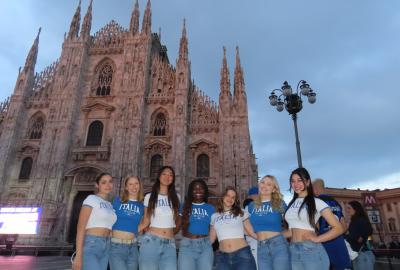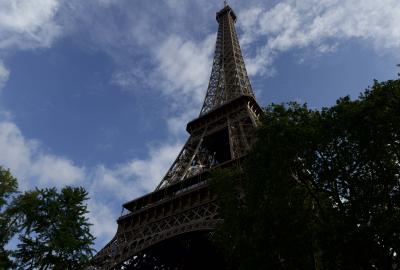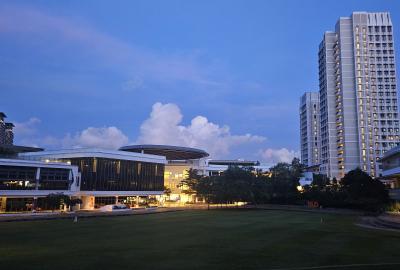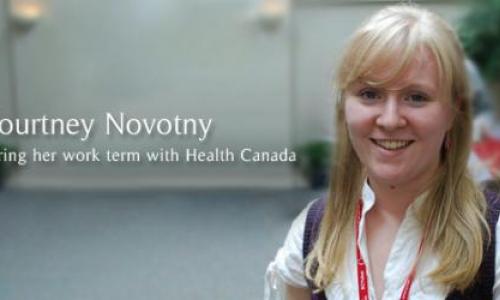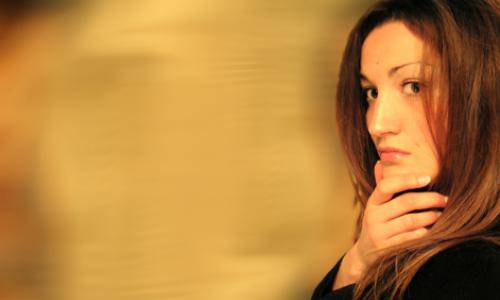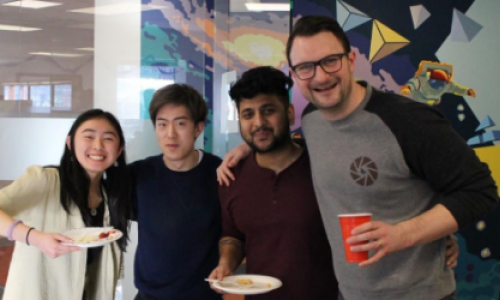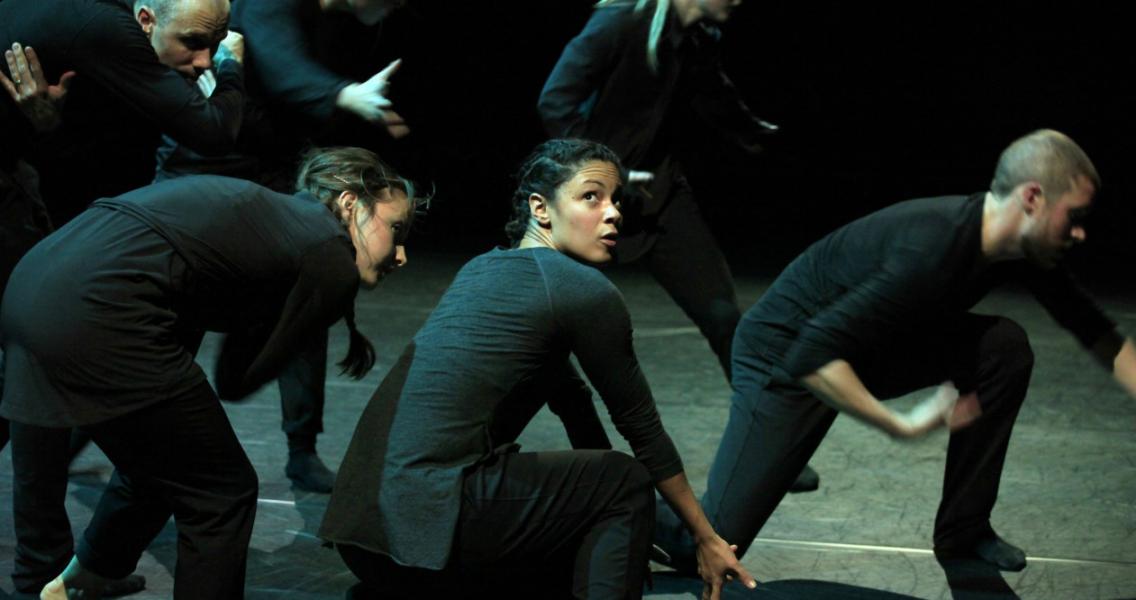
On a rainy Wednesday evening, I connected with Amber Funk Barton for a Skype interview. Amber is the artistic director of her own contemporary dance company, The Response Dance Society, founded in 2008. I am doing a dance internship with Amber’s company, better known as ‘the response.’ Amber is recognized for giving emerging artists opportunities to perform through her apprenticeship program. When she is not in artistic residencies, teaching, or choreographing on other dancers, Amber is performing work herself. She performed at Dances for a Small Stage in a comedic dance piece titled 80’s Dance Movie Debate, choreographed by Heather Laura Gray. This summer Amber choreographed Village, a piece for four virtuosic company dancers. Village was performed at the Dancing on the Edge Festival. Amber’s choreographic works are celebrated for their immense physical and emotional capacities, and are known to convey vivid stories through movement. As an emerging dance artist, I was thrilled to talk with Amber and delve into her past, as well as her upcoming solo work.
I know you’re currently in Victoria, BC in residence for your new and upcoming solo work. I was wondering if you could please tell me a bit about the piece and describe what exactly a day in residence entails?
Residence is always different depending on what type of residency you’re doing. The type of residency I’m experiencing at Dance Victoria is a production residency, which involves integrating all the production elements with the movement. For example, my lighting designer and set designer are here, and I have a costume prototype with me. It’s the first time that I’ve been putting all these elements together with the choreography. We have an arrangement with a brand new theatre located at Oak Bay High School; it’s where we can test everything out. While the production team is setting up in the theatre, I use the studio space at Dance Victoria to work on choreography. To many people, a residency is just studio space.
What are some central themes you’re exploring in your new solo work? Is there an inspiration that you are drawing from?
There’s this really beautiful quote, and maybe it’s quite obvious, by Carl Sagan. It talks about how the properties of our body and the makeup of our DNA are the same property as stars. I love the idea that we’re all connected so intrinsically and that we’re always living forever, in a different state. At the end of the day, life is really beautiful. It’s constant and there’s this rhythm that refuses to stop. The rhythm is mimicked in our heartbeat and even the flow of water; it’s everything and it permeates everything. Maybe it’s kind of a mid-life thing, but it’s a realization that we’re all connected on this planet and how you choose to interpret that is totally up to you. I wanted to celebrate the beauty of that and create something that makes people feel that they’re not alone, that they’re seen, that they matter, and that there’s hope. I think it’s also a result of the last piece I did that was little bit dark and very dramatic and dealing with death a lot.
This piece is lighter in a sense; it’s the opposite in wanting to experience something more celebratory and magical. I want this work to explore curiosity, wonder, and beauty, while resonating in something that really connects with people. The more I choreograph, the more I feel like I want to connect with the audience; to make them feel that they are part of the experience, not just me performing. There’s nothing wrong with that, but I really want to create an inclusive experience. Even though the audience is sitting in their seats, they can feel a connection or can see themselves in the work. Or they can ‘feel that way too’ in whatever capacity and that they’re not alone. So there are many different things feeding into why I want to make this work.
Recently, I had the pleasure of seeing you perform for Dances for a Small Stage at the Anza Club, in Heather Laura Grey’s piece 80’s Dance Movie Debate. I’m interested in knowing what your favourite ‘80s dance movie is and why?
It’s not even the ‘80s but the ‘70s and it’s called The Turning Point. It’s so over the top, cheesy and everything you think ballet companies are—the drama and the politics. Shirley MacLaine and Anne Bancroft are such fabulous performers. In that whole ‘80s debate, I think I’m a Footloose girl. There’s another movie made in the ‘80s called Dancers. Mikhail Barishnakov stars with Alessandra Ferri, the setting is Italy and it’s the remounting of Giselle by American Ballet Theatre. The way Giselle is filmed in Dancers is just breathtaking; Barishnakov’s execution of the choreography as well as Ferri’s performance as Giselle is just really beautiful.
I really enjoyed the Dances for a Small Stage piece ‘80s Dance Movie Debate and was brought to laughter quite a few times. While performing comedic dance pieces like Heather’s, were there some highlight moments for you in the process? How did you not give into laughter yourself during the wild moments in the piece?
We laughed a lot in rehearsal and sometimes really laughing in rehearsal gets it out of your system. The whole Flashdance scene where they’re in the car and Nneka Croal has the wig on and it’s so dramatic, “Stop the car! Stop the car!” she yells. I’m backstage just killing myself laughing. Billy Marchenski is so committed while he’s miming the driving. Both of them are so committed to their craft; it’s because they’re so awesome, I laugh too. There’s two other times I almost lose it. One time is when I’m on stage and Nneka comes on stage and she goes “I’m scared” and Billy is going “Footloooooose” out to the audience. I have a moment thinking that this is my life, this is it, this is what I do. So I just look off somewhere and try to think of something else. The other time I almost totally lose it is when Andrew Haydock has this dance at the end, he’s realizing ‘my fight is with the town’ and his little legs are going and I don’t even know what he’s doing. I think to myself this is amazing. I’m still learning my strategies of how not to laugh.
There’s another moment when we’re in the Dirty Dancing three person line and Billy is like, “Lock the frame”; it’s so specific. I say stupid stuff to myself like yes, I’m Baby, lock the frame Johnny; try to suspend disbelief. There was one night, you didn’t see it—and Andrew slid so far he fell off the stage and he had to come back over to me and we’re just looking at each other. It takes you a moment to regroup, but in those moments, I think it’s when you’re just about to laugh or feel your character slipping, you just have to take that extra beat or pause. The audience is with you and they are enjoying seeing you struggle and trying to hold on to it. Take that moment, take a breath, and breathe in.
I’m still learning a lot in terms of acting and comedy. Being surrounded by people like Billy and Nneka that are so talented, committed, open, and non-judgmental really gives you confidence to go there as well. Heather is a wonderful choreographer, her process and her experience. I found she never put any of us a position where we were unable to deliver the character. It’s so much a testament to everybody’s roles in that piece in particular.
I’m going to go for a trip down memory lane now, one of the first contemporary dance pieces I ever saw was Hero & Heroine in 2010 at The Cultch. I was just wondering, in your experience choreographing on Josh Martin, did you find the physical differences challenging? Specifically, being a female with a lower center of gravity. How did that translate and change your choreography?
I had the privilege of working with Josh quite a bit before that. At that point and time, I had a really good understanding of him and his vocabulary and how we worked together. We had been doing a lot of work together… I had a sense of what that was. I would forget when I was choreographing on him simple things like height; he is another head taller than me. Sometimes I would think, why can’t he do it in time, oh right, he is a head taller than me. Josh is great in that he would just rise to the challenge and match that. Before that piece, I had been considering female versus male dancers, so I felt that it wasn’t a question by the time I got to Hero & Heroine. To make a long story short, it sounds so simple, but it’s just the same. It’s just a body; you think it’s a big mystery. There’s certain things that, of course, the male body, in terms of the pure physicality of that body structure, that has different types of strengths versus a women. Not to say that a woman can’t do what a man can do and vice versa, but there’s things that come naturally to those different bodies. It’s an understanding, what could or could not happen or what could be challenged.
What I learned from working with a lot of wonderfully talented male dancers is that it’s just a body. Unless it’s pertaining to the content or the subject matter, if there’s nothing you have to connect it with, just think about it like it’s fluid, it’s a body moving, it’s space. It’s not male, nor female. The way we’re trained, especially with ballet is ‘men do this’ and ‘women is this’ so we get in our head—‘I don’t know how to choreograph on a guy’. Of course you do you! You take class with them.
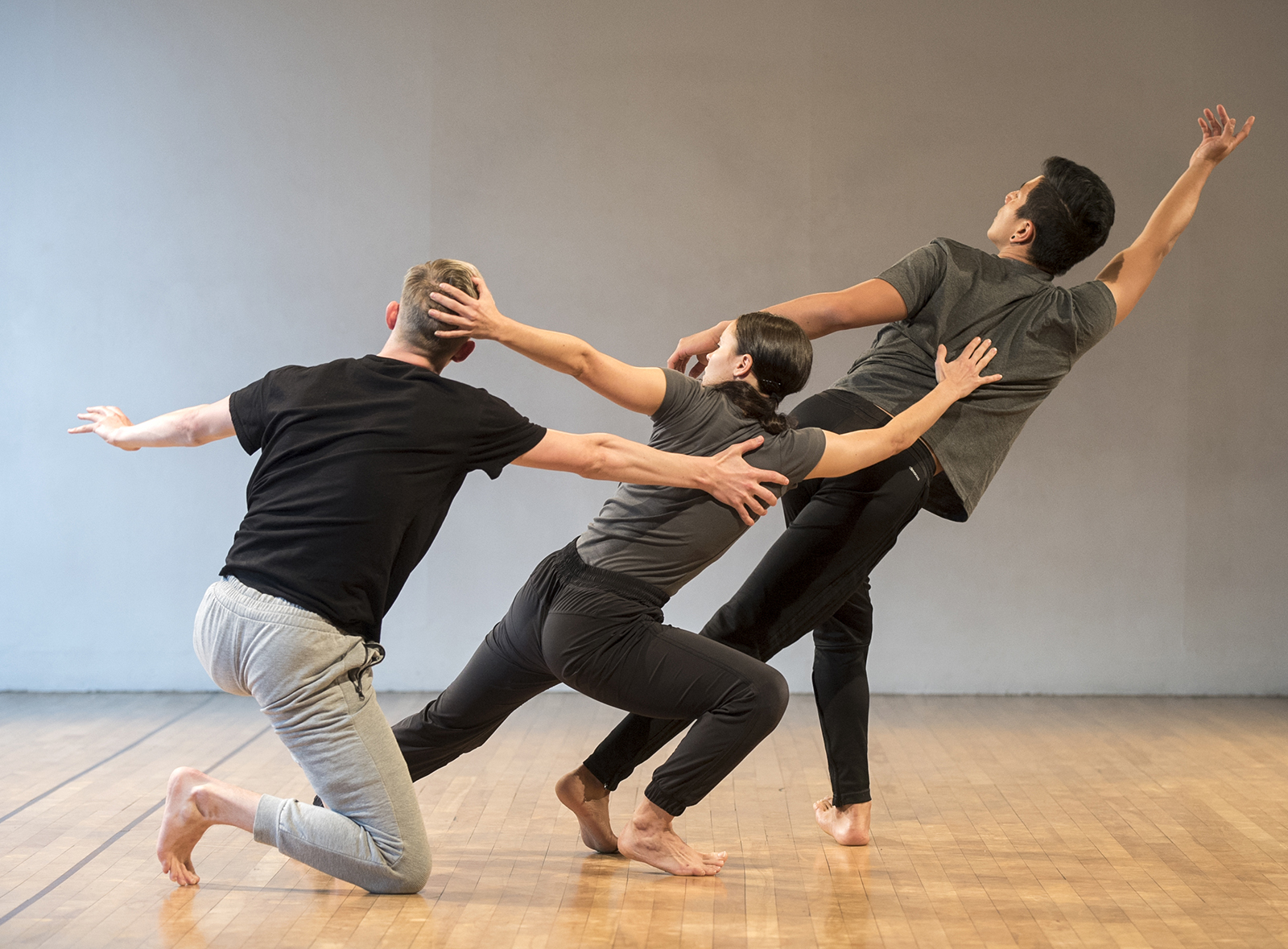
Andrew Haydock, Elya Grant and Antonio Somera Jr., Scenes for Your Consideration, 2016. Courtesy of The Dance Current, Photo: Chris Barton.
Partnering is a different issue, which is something I was investigating when I made Hero & Heroine. I feel the challenge was more about when you have a male and female duet, there’s a narrative involved that is automatic that you don’t have to try for; it’s automatically romantic. There are certain things that you have to accept if you’re going choreograph a male and female duet. You can’t change someone’s perception, but you can challenge a male and female relationship on stage. Or you can accept it and use it to your advantage. I have to say that Hero & Heroine was possibly one of the hardest things I’ve made, it was extremely challenging in many different ways. I learnt so much about choreography and myself and I’ll forever be thankful to Josh for being a part of that. Though it wasn’t a full-length work but a thirty-minute piece, I took away a lot from the experience and learnt so much about myself as a person, artist, and choreographer.
I’m interested in moving to Montreal once I’ve finished my degree in April and I’m wondering how you’d compare the contemporary dance scenes between Montreal and Vancouver. I found when I was there, it felt like an atmosphere of creativity and it seemed like it would be an inspiring place to be as a dancer. Could you please go into detail about what you experienced?
My time in Montreal was a limited experience. I was there off and on between 2010 and 2013 and I just got the sense that there are a lot more risks taken in terms of creativity. There’s a certain aesthetic and it’s not always technical in the body; there’s more content, ideas and performance risk. Rather than just physical steps, I feel like the West is very technical. In Montreal, it is dance, but it transcends past that fine line, it’s art. It’s because there’s a very strong content and idea that’s being expressed, and not to say that’s not happening in the West, this is my own personal opinion. I feel like in the West there is more contemporary dance that I’m exposed to and familiar performing in. There’s very much a Western technical virtuosity that’s expected. In Montreal there’s an understanding of ‘the artist’ needing to try things. They accept things that are uncomfortable, weird or challenging and the audience is understanding of the artist’s need to do that. Again that is happening in the West as well, but to a different extent and aesthetic.
That’s what I experienced during my short time in Montreal, catching whatever shows I could when I wasn’t in rehearsal. I feel like there’s a different influence of companies that come to Montreal to perform as opposed to Vancouver, it’s little bit closer to Europe. I would say some things that are similar to PuSh Festival in Vancouver because it’s all-inclusive performance. Montreal just has a totally different vibe for me; it was so great. The dance was just challenging everything and required a sense of vulnerability, whether you’re the interpreter or the creator.
Recently, you’ve been giving many opportunities to emerging professionals, such as myself, to work in the studio with you and other dancers. I was wondering if you could describe the main differences in the work ethic and performance when comparing professionals with apprentices and interns?
I think we’re all learning; no one ever gets a black belt in dance. I feel like with emerging artists, there’s still a sense of training that needs to be experienced. That’s also what I offer in conjunction with creation when working with emerging artists. It’s that understanding of the transference of what you’re doing in the studio and how it goes onto the stage. Of course everybody knows how to perform or has performed at that point in time, but it’s trying to communicate a deeper understanding of what that shift is. I try to have the apprenticeship program when I’m also working with the company. I know as a young dancer, I learned the most when I was observing a company. There are some things that you learn in observing that you cannot teach. If you’re lucky enough, there’s professionals in the room that set the standard and make an impression on you for the rest of your life—experiencing how a professional interacts with the choreographer, treats other dancers, and cooperates with everyone.
With apprenticeships, there’s a lot of what we call ‘shadowing’—being in the studio and following someone. At the end of the day as an apprentice, you’re not really accountable. In the back of your mind, you’re maybe thinking, ‘well I’m not going to perform it’, but there’s a possibility of getting a job. There’s not the same accountability; I know that when I have apprentices or the interns, they will be performing. As an emerging artist, you are accountable and put the experience on your CV—really own it. That’s what I really want for the dancers I work with, that they can really own that credit, experience, and learn something. I really do love teaching and mentoring; there’s so many things when I was younger I wish somebody would have told me. I have a soft spot for emerging dancers because it can be so overwhelming. You don’t know if you’re doing anything right or if it’s actually working or not. As an emerging artist you really need someone to provide you with a goal to focus on so you don’t lose your direction.
One last really big and open-ended question: what makes you dance?
Dance is just so natural; it sounds so cliché, but I literally can’t remember a time I wasn’t dancing. Even as an only child, dancing is how I’ve always expressed myself. Dancing is how I feel the most me. When I dance, I feel like I don’t have to apologize for who I am or what I do. For whatever span of time, for that hour or whenever I’m on the stage, I can completely forget everything. It’s like that freaking Billy Elliot quote ‘I’m free’; that’s the best way I can describe it. I love the rigour and challenge of dance and the ability to communicate with people without literally speaking. Dance is an ambiguous way everybody, at a certain point, can understand; it’s because dance is very intuitive. Whether we think we can dance or not, we’re all deeply connected by rhythm, harmony and movement. Dance is such a constant, it’s part of my DNA; it’s how I see and move through the world. Even if I don’t necessarily dance per se, I’ll always be creating. You’re always creating, you hear something and it triggers an idea. It sounds like such a cop out answer, but it’s a part of who I am.

